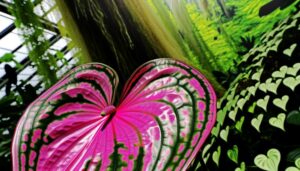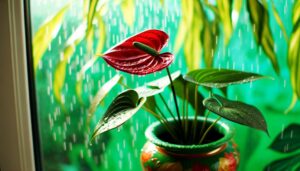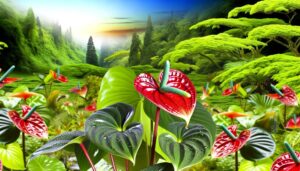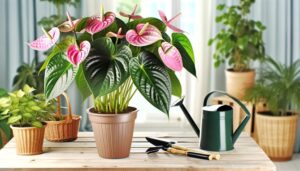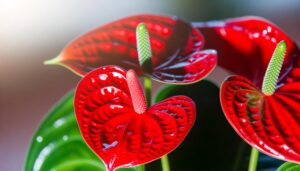Why Is Anthurium Red Hot so Unique?
Anthurium Red Hot is distinguished by its vibrant red spathes, which are a result of anthocyanin pigments, and its glossy green foliage protected by dense cuticular waxes. The plant's large heart-shaped leaves optimize light absorption, facilitating efficient photosynthesis.
Scientifically, it enhances indoor air quality by absorbing volatile organic compounds (VOCs) such as formaldehyde, ammonia, and xylene. Additionally, its minimal care requirements, ability to thrive under indirect sunlight, and extended bloom duration contribute to its low maintenance nature.
Its unique combination of visual appeal, physiological efficiency, and air-purifying capabilities makes it exemplary among houseplants. Explore further to uncover its full scientific marvel.
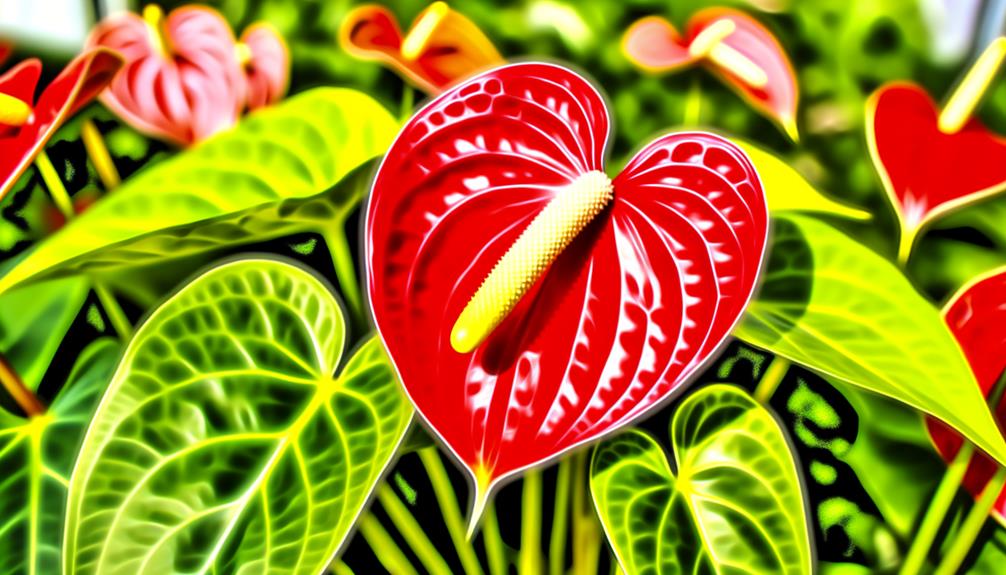
Key Takeaways
- Striking red spathes with anthocyanin pigments provide a vibrant and exotic aesthetic.
- Glossy green, heart-shaped leaves enhance light absorption and efficient photosynthesis.
- Removes harmful toxins like formaldehyde, ammonia, and xylene to improve indoor air quality.
- Resilient with minimal care, thriving under indirect sunlight and moderate watering.
- Long-lasting blooms up to eight weeks reduce maintenance and enhance decor versatility.
Striking Red Spathes
How does the Anthurium Red Hot achieve its remarkable visual appeal through its striking red spathes, which are botanically modified leaf structures known for their vibrant coloration and unique morphology?
The vivid red hue of the spathes is due to anthocyanin pigments, which are prominent in the plant's epidermal cells (Chalker-Scott, 1999). These pigments absorb light in the blue-green spectrum, reflecting red wavelengths, thereby creating the intense coloration.
Additionally, the spathes' robust structure, composed of specialized cells known as sclerenchyma, provides mechanical support and durability (Evert, 2006).
The combination of these pigments and structural adaptations not only enhances the Anthurium Red Hot's aesthetic but also plays a role in attracting pollinators, thereby facilitating reproductive success.
Glossy Green Foliage
The Anthurium Red Hot's glossy green foliage exhibits a remarkable luster due to the presence of a dense layer of cuticular waxes, which minimize water loss and reflect light, contributing to the leaves' shiny appearance (Barthlott et al., 1998).
This unique characteristic is not merely aesthetic but also serves several functional roles:
- Water Retention: The waxy cuticle reduces transpiration significantly, thereby conserving water in the plant's tissues (Kerstiens, 1996).
- Light Reflection: The glossy surface reflects excess light, safeguarding the plant from potential photodamage (Gutschick, 1999).
- Pathogen Defense: The smooth, waxy surface serves as a barrier to pathogens, decreasing the risk of infection (Jeffree, 2006).
Understanding these aspects highlights the plant's evolutionary adaptations for survival and aesthetic appeal.
Air-Purifying Qualities
The Anthurium Red Hot exhibits significant air-purifying qualities, effectively removing harmful toxins such as formaldehyde, ammonia, and xylene from indoor environments.
Scientific studies, including those by NASA, have demonstrated the plant's capability to enhance indoor air quality by absorbing volatile organic compounds (VOCs).
Consequently, its presence promotes healthier breathing and contributes to overall well-being.
Removes Harmful Toxins
Removing harmful toxins from indoor air, Anthurium Red Hot demonstrates significant air-purifying qualities, as evidenced by scientific studies on its ability to absorb volatile organic compounds (VOCs). Research indicates that this plant can effectively mitigate specific indoor pollutants, enhancing air quality through phytoremediation. The process involves the plant's roots, leaves, and associated microorganisms working synergistically to degrade toxic compounds.
Key benefits include:
- Formaldehyde Removal: Anthurium Red Hot absorbs formaldehyde, a common indoor pollutant found in building materials and household products (Wolverton, 1989).
- Benzene Absorption: This plant reduces benzene levels, a harmful solvent prevalent in paints and detergents (Orwell, et al., 2004).
- Trichloroethylene Uptake: It also captures trichloroethylene, a carcinogenic compound used in industrial processes (Wood, et al., 2002).
Such characteristics underscore its value in improving indoor environments.
Enhances Indoor Air
Leveraging its impressive phytoremediation capabilities, Anthurium Red Hot greatly enhances indoor air quality by systematically absorbing and breaking down various airborne toxins. Specific studies have identified this plant's efficiency in sequestering volatile organic compounds (VOCs), such as formaldehyde, xylene, and toluene, which are commonly found in indoor environments (Wolverton et al., 1989).
The plant's stomatal conductance and cuticular absorption pathways facilitate the uptake of these pollutants, followed by enzymatic degradation within its cellular structures. The Anthurium Red Hot exhibits a high transpiration rate, promoting increased humidity levels, which can indirectly reduce particulate matter in the air.
These combined mechanisms underscore the plant's effectiveness as a biological filter, contributing significantly to enhanced indoor air quality.
Promotes Healthier Breathing
Anthurium Red Hot's air-purifying qualities are attributed to its unique ability to sequester harmful airborne pollutants through specialized physiological and biochemical processes. This plant exhibits exceptional efficacy in improving indoor air quality by mitigating volatile organic compounds (VOCs) and other toxicants.
Research indicates that Anthurium Red Hot employs a combination of stomatal regulation and enzymatic degradation to purify the air.
Key mechanisms include:
- Stomatal Regulation: Facilitates gas exchange, allowing absorption of pollutants.
- Enzymatic Degradation: Metabolizes VOCs into harmless compounds.
- Transpiration Process: Enhances humidity levels, contributing to respiratory health.
These attributes collectively underscore the Anthurium Red Hot's crucial role in promoting healthier breathing environments, substantiating its status as a superior air-purifying plant.
Low Maintenance Needs
Due to its resilient nature and minimal care requirements, the Anthurium Red Hot is particularly well-suited for both novice and experienced plant enthusiasts. This species thrives under indirect sunlight, and its watering needs are moderate, reducing the risk of overwatering—a common pitfall for many houseplants. Additionally, it adapts well to various indoor environments, requiring only occasional pruning to remove dead leaves and maintain its aesthetic appeal (Govaerts & Frodin, 2002).
| Requirement | Details |
|---|---|
| Light | Indirect sunlight, low-light tolerance |
| Watering | Moderate, allow soil to dry between watering |
| Soil | Well-draining potting mix |
| Humidity | Prefers high humidity, but adaptable |
This low-maintenance profile underscores its suitability for diverse indoor settings, ensuring longevity and sustained growth with minimal intervention.
Tropical Aesthetic Appeal
Anthurium Red Hot exemplifies a quintessential tropical aesthetic through its vibrant color palette and exotic leaf structure, contributing to its horticultural appeal (Barthlott et al., 2007).
The plant's bracts exhibit a spectrum of intense reds, which are anthocyanin pigments that play an essential role in pollinator attraction and photoprotection (Grotewold, 2006).
Additionally, the elongated, heart-shaped leaves, characterized by robust venation patterns, enhance its ornamental value and mimic natural rainforest foliage, aligning with the principles of biomimicry in landscape design (Specht & Bartlett, 2009).
Vibrant Color Palette
The Anthurium Red Hot's vibrant color palette, characterized by its striking red spathes and contrasting green foliage, is a prime example of the species' adaptation to attract pollinators in its native tropical habitat. This chromatic brilliance serves several ecological and physiological functions:
- Pollinator Attraction: The intense red hue is highly visible to pollinators such as bees and butterflies, facilitating effective pollination (Glover, 2011).
- Photosynthetic Efficiency: Contrasting green leaves optimize light capture through enhanced chlorophyll concentrations, promoting photosynthesis (Taiz & Zeiger, 2010).
- Herbivore Deterrence: Bright colors often signal toxicity or unpalatability to herbivores, reducing predation (Cipollini, 2004).
These attributes underscore the Anthurium Red Hot's evolutionary success in its ecological niche, combining aesthetics with functional adaptations.
Exotic Leaf Structure
Complementing its vibrant color palette, the Anthurium Red Hot's exotic leaf structure further enhances its tropical aesthetic appeal through features such as large, glossy leaves with a heart-shaped morphology that maximizes surface area for photosynthetic activity (Jones & Schenk, 2006). These leaves not only contribute to efficient light absorption but also play a role in regulating water loss through their waxy cuticle. The following table summarizes key features:
| Feature | Description |
|---|---|
| Leaf Size | Large, enhancing photosynthetic capacity |
| Surface Texture | Glossy, reducing water loss via cuticular transpiration |
| Morphology | Heart-shaped, optimizing light capture and gas exchange |
| Aesthetic Contribution | Adds to the plant's overall tropical and exotic appearance |
Such structural attributes make Anthurium Red Hot an exemplary model for both scientific study and ornamental use.
Versatility in Decor
Renowned for its striking red spathes and lush green foliage, the Anthurium Red Hot offers unparalleled versatility in interior design applications, seamlessly integrating into both modern and traditional decor schemes. Its adaptability is underscored by its physiological properties and aesthetic appeal:
- Color Contrast: The vivid red spathes provide a dynamic focal point against neutral backgrounds, enhancing visual interest.
- Spatial Dynamics: Its compact growth habit makes it suitable for various spatial arrangements, from tabletop displays to larger installations.
- Air Purification: According to studies by NASA, Anthuriums contribute to indoor air quality by removing pollutants, making them functional as well as decorative.
Such multifaceted attributes make the Anthurium Red Hot a preferred choice for designers aiming to merge beauty with functionality.
Long-Lasting Blooms
In addition to its versatility in decor, the Anthurium Red Hot is celebrated for its long-lasting blooms, which can last up to eight weeks, stretching the visual impact and reducing the frequency of replacement in both residential and commercial settings.
This remarkable longevity is attributed to the plant's robust spathes and spadices, which possess a thick, waxy cuticle layer that minimizes water loss and pathogen entry (Stancato et al., 2002).
Moreover, the Anthurium's efficient vascular system guarantees optimal nutrient transport, maintaining turgor pressure and cellular integrity over extended periods.
This enduring bloom period not only enhances aesthetic appeal but also offers economic advantages by lowering maintenance costs, making the Anthurium Red Hot a preferred choice for sustainable ornamental horticulture.
Conclusion
Anthurium Red Hot's uniqueness is underscored by its striking red spathes, complemented by glossy green foliage, enhanced by air-purifying qualities, characterized by low maintenance needs, epitomized by a tropical aesthetic appeal, and marked by versatility in decor.
The species' long-lasting blooms further augment its desirability, offering both ornamental and functional benefits.
Such attributes collectively position Anthurium Red Hot as a distinguished plant within horticultural and interior design disciplines, meriting its recognition and study.

